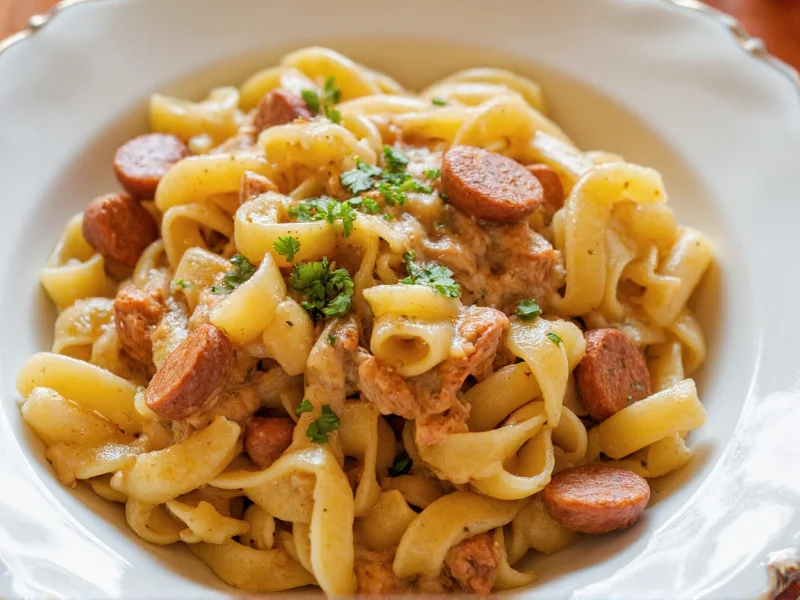Creating the perfect chicken and sausage pasta requires understanding the synergy between quality ingredients and proper technique. This versatile dish works equally well as a weeknight dinner solution or an impressive meal for casual entertaining. The magic happens when you properly sear the proteins to develop fond, then build layers of flavor through deglazing and simmering.
Essential Ingredients for Success
The foundation of exceptional chicken and sausage pasta lies in selecting the right components. For the proteins, choose Italian sausage (sweet or spicy based on preference) and boneless, skinless chicken thighs, which remain tender during cooking unlike breasts that can dry out. Opt for high-quality pasta like penne, rigatoni, or fusilli that can hold substantial sauce.
| Ingredient Category | Recommended Choices | Avoid |
|---|---|---|
| Protein | Chicken thighs, Italian sausage (sweet or spicy) | Pre-cooked chicken, low-quality sausage with fillers |
| Pasta | Penne, rigatoni, fusilli | Thin noodles like angel hair |
| Sauce Base | Canned San Marzano tomatoes, chicken broth | Heavy cream-based sauces (unless specified) |
| Aromatics | Fresh garlic, yellow onion, bell peppers | Pre-minced garlic in jars |
Step-by-Step Preparation Guide
Mastering the one pot chicken and sausage pasta technique eliminates unnecessary dishes while maximizing flavor development. Begin by partially cooking your sausage in a large skillet, removing about half to create textural contrast. In the same pan, sear chicken thighs until golden, then set aside. The fond left in the pan is flavor gold—don't wash it away.
Sauté onions and bell peppers until softened, then add garlic and red pepper flakes for aromatic depth. Deglaze with a splash of white wine or chicken broth, scraping up all those delicious browned bits. Return all proteins to the pan with crushed tomatoes, broth, and uncooked pasta. The starch released from the pasta as it cooks thickens the sauce naturally.
Cover and simmer for 12-15 minutes until pasta reaches al dente and chicken is cooked through (165°F internal temperature). Finish with fresh basil, a drizzle of quality olive oil, and grated Parmesan. This easy chicken and sausage pasta recipe creates a cohesive dish where every element complements the others.
Popular Variations to Explore
While the classic tomato-based version remains popular, several delicious variations cater to different preferences. For a creamy chicken sausage pasta, substitute half the broth with heavy cream or full-fat coconut milk for dairy-free options. Add sun-dried tomatoes and olives for a Mediterranean twist, or incorporate roasted red peppers and a touch of smoked paprika for depth.
Those seeking a healthy chicken and sausage pasta can use turkey sausage and increase vegetable content with zucchini, mushrooms, or spinach added during the final minutes of cooking. For spicy enthusiasts, choose hot Italian sausage and add Calabrian chiles for authentic heat that builds gradually.
Pro Tips for Perfect Results Every Time
Achieving restaurant-quality chicken and sausage pasta with penne at home requires attention to detail. Always salt your cooking water adequately—it should taste like the sea—to properly season the pasta from within. Don't skip the searing step; proper browning creates complex flavor compounds through the Maillard reaction.
Reserve a cup of starchy pasta water before draining—this magical liquid helps emulsify and thicken sauces. When combining ingredients, the sauce should be slightly loose as pasta continues absorbing liquid off-heat. For the best texture, undercook pasta by one minute if finishing in sauce.
Storage and Reheating Instructions
Properly stored, chicken and sausage pasta maintains quality for 3-4 days in airtight containers. When reheating chicken sausage pasta with tomato sauce, add a splash of broth or water to restore moisture. Microwave in 30-second intervals stirring between, or gently warm on stove over low heat. Avoid high temperatures that can make chicken rubbery.
For meal prep enthusiasts, this quick chicken and sausage pasta dinner freezes well for up to three months. Thaw overnight in the refrigerator before reheating. Freezing actually improves flavor integration for tomato-based versions, making it an excellent make-ahead option.
Frequently Asked Questions
Can I use chicken breast instead of thighs in chicken and sausage pasta?
Yes, but chicken breasts require careful timing to prevent drying out. Cut breasts into 1-inch cubes and add them later in the cooking process—about 5-7 minutes before completion. Thighs remain more forgiving due to higher fat content, making them preferable for one-pot methods where precise timing is challenging.
What's the best pasta shape for chicken and sausage pasta?
Ridged or tubular shapes like penne rigate, rigatoni, or fusilli work best as they trap sauce and small meat pieces. These shapes provide the ideal surface area-to-sauce ratio, ensuring each bite contains balanced elements. Avoid delicate shapes like angel hair that can't stand up to hearty proteins.
How can I prevent my chicken and sausage pasta from becoming dry?
Maintain proper liquid ratios—use a 2:1 broth-to-pasta ratio when cooking pasta directly in the sauce. The starch released from pasta naturally thickens the sauce without drying. If sauce appears tight during cooking, add additional broth 1/4 cup at a time. Finish with a drizzle of olive oil which coats ingredients and preserves moisture during storage.
Can I make chicken and sausage pasta ahead of time?
Yes, this dish actually benefits from flavor integration when made ahead. Prepare completely, then cool rapidly before refrigerating. When reheating, add liquid as the pasta continues absorbing moisture. For best results, undercook pasta slightly (by 2 minutes) if planning to reheat later, as it will continue cooking during storage and reheating.
What vegetables pair well with chicken and sausage pasta?
Bell peppers, onions, and garlic form the classic soffritto base. For additional nutrition, stir in spinach or arugula during the last two minutes of cooking. Roasted mushrooms, zucchini, or eggplant work well for heartier versions. Add delicate greens off-heat to preserve texture and color. Avoid watery vegetables like tomatoes that can dilute your sauce.











 浙公网安备
33010002000092号
浙公网安备
33010002000092号 浙B2-20120091-4
浙B2-20120091-4